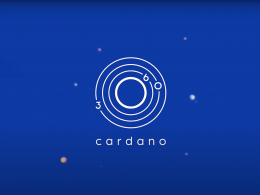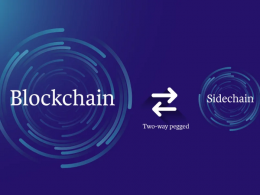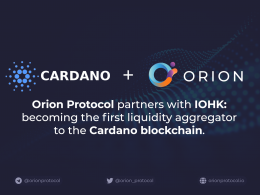I hope that you all are as hyped to learn about the exciting developments within the Cardano ecosystem as I am! This month’s edition of Cardano 360 is jam packed with a number of key updates on the following topics. Be sure to read this all the way through as it contains a lot of valuable information. You can also find links to the topics discussed at the very end.
- Updates on the Alonzo Smart Contract Rollout
- Updates on the peer to peer rollout
- Partnership updates
- Nervos Network
- Orion Protocol
- Revuto
- NFTs in the Cardano Ecosystem
- Thoughts on the NFT Marketplace with Jonah and Collin: The Main Takeaways
- Wolfram Blockchain Labs and COTI are creating a NFT auction site for the Cardano ecosystem
- Additional NFT projects on the Cardano ecosystem
- Updates on Project Catalyst
- Research Updates with Dr. Aggelos Kiayias, the Chief Scientist at IOHK
Updates on the Alonzo Smart Contract Rollout
What is Alonzo?
The ‘Alonzo’ hard fork will bring exciting and highly-anticipated new capabilities to Cardano through the integration of Plutus scripts (i.e., the plutus Platform is the smart contract platform for Cardano) onto the blockchain. These will allow for the implementation of smart contracts in Cardano, enabling the deployment of a wide range of new DeFi applications for the first time. We are currently in the Alonzo Blue phase of development and this stage is supported initially by a small group of SPOs, partners and Plutus Pioneers. For more information on the Plutus programming language and what smart contracts are, visit https://developers.cardano.org/en/programming-languages/plutus/overview/.
Figure 1. Alonzo smart contract rollout timeline
How is the progress on Alonzo Blue?
Everything is going according to plan with Alonzo Blue. What started as a test net with 6 stake pool operators (SPOs), has grown to around 20. We are still in the early stages of Alonzo Blue, but we may progress to Alonzo White in about a week or so. Alonzo White represents a key milestone and will enable more SPOs and Pioneers to take place in the implementation of the Alonzo rollout.
Figure 2. The Alonzo Blue and Alonzo White Rollout plans
I want to get involved, can I learn how to write smart contracts?
Yes! The Plutus pioneer program is a program designed to recruit and train developers in Plutus for the Cardano ecosystem. When you join this program, you will become part of a group with early access to a set of courses that teach you the core principles of how to code in both Haskell and Plutus. It will be highly interactive, with weekly videos, exercises, and Q&A sessions, along with exclusive access to the creators and key experts in the language. You will also be able to join a dedicated community channel, created to help pioneers connect to each other as you learn.
The second course is an eight week program over the summer period that will start on July 1st and run through to August 26th. It will involve approximately ten hours a week of your time and efforts. If you are interested in applying to the Plutus pioneer program visit, https://developers.cardano.org/en/plutus-pioneer-program/.
Updates on the Peer to Peer Rollout
What is “peer to peer” and why is it important to the Cardano Network?
The current Cardano network is federated and not fully decentralized. To ensure that the network is fully decentralized, the network will transition to a fully peer to peer network. A fully decentralized peer to peer network is one of the three fundamentals which will enable the complete decentralization of the Cardano network (see Figure 3). The decentralization of 1) block production (through the proof of stake consensus mechanism) and 2) governance (through the participation in project Catalyst), represent the other two fundamental components required for full decentralization.
Figure 3. The three fundamentals of full decentralization of the Cardano ecosystem
What is next for the “peer to peer” rollout?
Currently, there are multiple peer to peer nodes running fully integrated on the main net as test relays. The next step will involve a public test net where SPOs are invited to run peer to peer relays, with the final step being full peer to peer integration into the Cardano network.
Partnership Updates
Nervos Network
What is the Nervos Network and what problem does it seek to address?
Nervos is a layer 1, UTXO based blockchain network with a proof of work consensus mechanism. At the present moment, blockchain networks (e.g., Cardano, Polkadot, Ethereum, Bitcoin, etc.) are siloed and are unable to communicate with one another. Ultimately, this means that ADA holders are currently unable to use ADA in the decentralized applications (dAPPs) of other blockchain ecosystems. Nervos is hoping to address this lack of blockchain interoperability by building bridges to other blockchains. To this end, Nervos and Cardano are partnering to build a bridge between the two blockchains.
What does the partnership between Cardano and Nervos hope to achieve?
The development of dAPPs on the Nervos and Cardano blockchains are both in the nascent stage, and with time, these communities will produce rich and powerful technologies. The bridge between Nervos and Cardano seeks to leverage the technology of these developing ecosystems, allowing them to be fully interoperable. Ultimately, this means that ADA holders will be able to wrap their ADA and use it in dAPPs on the Nervos blockchain and vice versa. This bridge is in active development and a working test net is expected within the next month, and the main net should follow shortly after.
Instead of viewing blockchains as competing entities, Nervos and Cardano view each as their own unique community, each working to solve different problems. In the future, there will be many blockchains, with a singular interoperable experience for users. Does this send chills up your spine, like it does mine? Early internet vibes here.
Orion Protocol
What is Orion Protocol and what problem does it seek to address?
The digital asset market is in desperate need of liquidity and at the present moment, the majority of digital assets are managed through transactions on centralized exchanges (i.e., Binance, Voyager, Kraken, etc.). Different digital asset types, from different blockchains are managed on different exchanges ultimately creating siloed liquidity pools. Furthermore, there is a lack of technology and infrastructure to bridge all of these networks together – as such, there is no single point of access to the digital asset market. This siloed nature ultimately impedes the recruitment of new digital asset holders and mainstream adoption.
Orion Protocol is creating a blockchain agnostic aggregator that serves as an entrance to the entire digital market. Orion Terminal, Orion’s flagship product, is the first decentralized gateway to the digital asset market that combines the liquidity from centralized exchanges, decentralized exchanges, and swap pools to create a single non-custodial platform that functions across all jurisdictions for the first time. The benefit and importance of this decentralized gateway cannot be overstated as centralized exchanges are vulnerable to a number of security issues. Remember – not your keys, not your crypto. The Orion Protocol hopes to achieve this for all digital assets, e.g., crypto currency, non-fungible tokens (NFTs), even stocks and commodities. In the NFT space, Orion Terminal will soon launch an aggregated NFT marketplace, built on the Cardano blockchain. This will allow users to use ADA to purchase NFTs and move NFTs from other blockchains, to the Cardano blockchain.
Why has the Orion Protocol chosen to build on the Cardano Network?
Creating this blockchain agnostic aggregator is no small task and requires building on a fast, efficient, robust and scalable network that is already synced up with other blockchains, this is where Cardano comes in. Cardano is building a blockchain that is able to understand what other blockchains are doing in effort to become the internet of blockchains. By building on the Cardano network, what will become the internet of blockchains, Orion Protocol will be able to achieve their vision of blockchain interoperability.
Revuto
What is Revuto and what are its plans on the Cardano network?
Revuto allows users to manage active subscriptions (i.e., Netflix, Spotify, Hulu, etc.) each month, allowing users to manage each of their subscriptions on a rolling basis.
In May, Revuto successfully launched the first token sale on Cardano and first token sale and raised $10 million USD. In the next three months, Revuto will be launching 1) NFTs for those who took place in the token sale and 2) version 1 of their subscription management application.
NFTs in the Cardano Ecosystem
Thoughts on the NFT Marketplace with Jonah and Collin: The Main Takeaways
- Over the last three years, the NFT marketplace has grown more than 700%, with an estimated global market of $370 billion (see figure 4).
Figure 4. The NFT marketplace is growing at a rapid pace
- The sports NFT marketplace is growing at a rapid rate and we are seeing exciting projects ranging from sports based NFTs, to sports based dAPPs that use NFTs, lottery models, and even fan based ownership where token holders vote on important team decisions
- Multiple industries (i.e., sports, entertainment, etc.) are now applying blockchain technology to ticketing, enabling the seamless and verifiable transfer of tickets between individuals
- The world of physical and digital valuables will merge in the future. Jewelry, art, and other rare collectables will most likely have a digital NFT twin which will allows customers and companies the ability to verify the authenticity of the goods. NFTs could also help provide proof of origin for valuable foods and wines as well
Wolfram Blockchain Labs and COTI are creating a NFT auction site for the Cardano ecosystem
Continuing the conversation around NFTs, the partnerships between Wolfram, COTI and IOHK to bring the first NFT auction site to the Cardano ecosystem was highlighted. Wolfram will be focusing on the minting and front end processes and COTI, the organization who launched ADAPay on Shelly mainnet, is working on the bidding mechanisms, including analyzing Ada balances and providing custodial wallets to users. Ultimately this means that ADApay will become an NFT auction mechanism, on top of a payment mechanism. To showcase these technologies, Wolfram plans to mint NFTs on the Cardano blockchain.
Additional NFT projects on the Cardano ecosystem
- NFT-maker.io is currently the easiest way to mint NFTs on the Cardano blockchain and version 2 is right around the corner. In this second version, NFT-maker.io will enable the minting of NFTs and also function as a decentralized NFT marketplace running on Cardano
- Check out the artwork from Jes (Jes-art.com), who is an artist from which you can purchase both a canvas painting and its digital NFT twin
- Alessandro Konrad from Spacebudz.io is creating a Spacebudz wallet and marketplace
- CardanoSpace.com is the first NFT on Cardano with utility value, such that virtual real-estate comes with each NFT that you purchase
- Adrian from pxlz.org, has created the first interactive NFTs on Cardano
Updates on Project Catalyst
Project Catalyst is the largest decentralized innovation fund on the planet!
- Registration for Fund4 has since ended
- There was a 10% rise in participation from Fund3
- More than 23,000 unique wallets participated in Fund4
- A total of 2.3 billion ADA was utilized in the registration of Fund4
- Voting for Fund4 ended on June 25th
- Registration for Fund5, which will designate 2 million Ada to selected projects, will start on July 8th
- More than 27,000 people are now participating on IdeaScale and that number is growing rapidly each day
- ‘Swarm’, a new bottom-up community venture has been piloting live and open community discussions around development within the Cardano ecosystem
- A community-build voting assistant tool has been built – https://cardanocataly.st/voter-tool/#/
- By Fund5, there will be more than 120 projects building a diverse array of decentralized projects on the Cardano network
- Fund6 will launch in August and will delegate $4 million USD worth of ADA
- By Fund6, registration and voting will be more accessible
Research Updates with Dr. Aggelos Kiayias, the Chief Scientist at IOHK
What is cryptography?
- Cryptography as a discipline has been driven by the internet, and the idea that if you want to fully take advantage of what the internet has to offer, than you will need secure and reliable forms of communication and identity management. Cryptography seeks to solve these problems by organizing digital systems so that trust is redistributing across their components in such a way that susceptibility to attacks are minimized
As an industry, where are we in terms of maturity of crypto based projects? How is IOHK leading the field?
- IOHK has truly been leading the field in terms of research and project development, but we are truly at the beginning of this journey
- IOHK strives to be at the forefront of crypto based research and to do so they have a 3-pronged approach, 1) a team of in-house researchers, 2) imbedded researchers who work at University labs, but are funded my IOHK, and 3) external collaborators who also seek to forward IOHK’s research program.
What are the updates on the research front?
- In the past few months, there have been a number of publications. Perhaps the most important recently published manuscript was that on Hydra, that appeared in Financial Cryptography in February of 2021. This was the first published manuscript on the Hydra protocol suit
- Ouroboros Chronos was accepted for presentation by the prestigious conference, Eurocrypt 2021. The Ouroboros Chronos protocol demonstrates how it is possible to build a global concept of time on a blockchain that can feed into all other components and/or dAPPs
- Mithral is also another key research initiative which seeks to build lite clients. Mithral focuses on what is known as a succinct non-interactive argument of knowledge (SNARK), which is a cryptographic primitive which allows one to create a very short proof about a specific statement, which enables extremely fast validation. In short, this would allow an ADA holder to access the Cardano blockchain extremely quickly.
Closing Remarks
We hope that you all are as excited about these amazing developments within the Cardano ecosystem as we are. What are you most excited about and what are you looking forward to the most? We look forward to your comments below!
If you haven’t watched Charles’ interview with Lex, you need to make that a priority. ☺ Here is the link, https://www.youtube.com/watch?v=FKh8hjJNhWc&t=16172s
Key Links
Full Cardano 360 episode: https://www.youtube.com/watch?v=al5m14299ww&t=298s
Become a Plutus pioneer
Apply for the the Plutus Pioneer Program: https://bit.ly/3wUMmmb
Support our partners
Nervos: https://bit.ly/2T0S5bi
Orion Protocol: https://bit.ly/3zWZ4m7
Revuto: https://bit.ly/3vQOom0
Cardano Foundation Jobs: https://bit.ly/2UxQ9Yi
Jobs at InputOutput: https://apply.workable.com/io-global/…
Wolfram Blockchain Labs: https://bit.ly/3y2Mr7B
COTI Group: https://coti.io/
Join Project Catalyst
Project Catalyst IdeaScale: https://cardano.ideascale.com/
Project Catalyst Community-Built Voting Assistant: https://cardanocataly.st/voter-tool/#/
Check out IOHK’s blog
Latest blog posts: https://iohk.io/en/blog/posts/page-1/
Register for the Cardano summit
Summit registration: https:// summit.cardano.org










